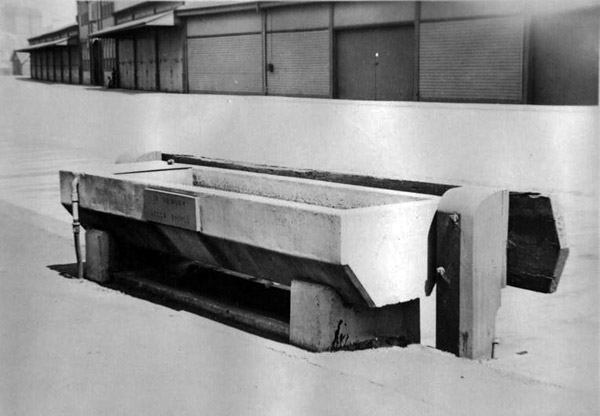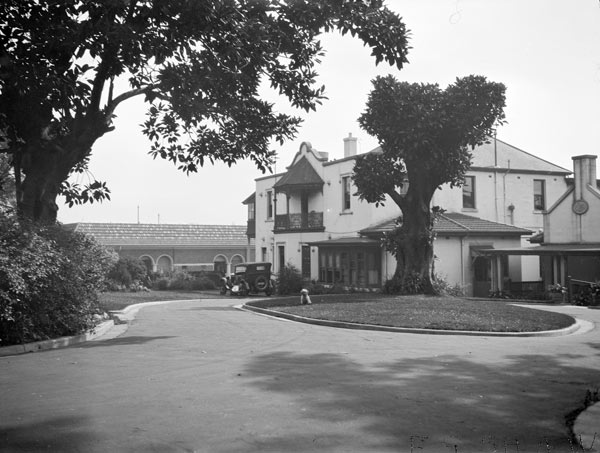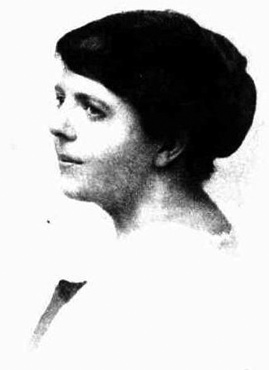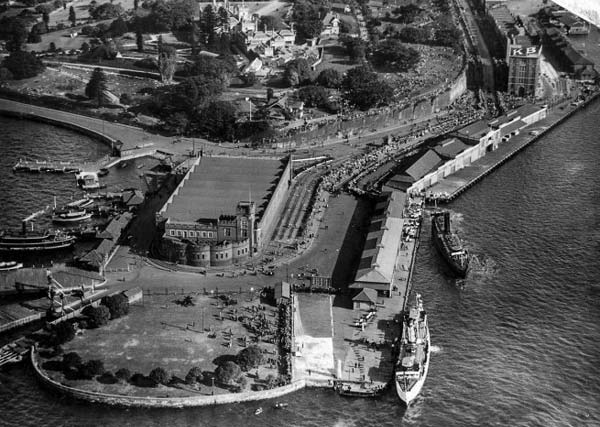© John Low
I discovered the accompanying photograph some years ago in the archives of the City of Sydney. Photographic collections such as theirs generally include a good proportion of images depicting people, buildings and other objects now long gone and can often seem like ‘cabinets of curiosities’, full of secrets and lost histories.
The photograph, taken by the City Council’s Cleansing Department in the 1930s, shows a simple, though elegant, horse trough that once stood on the wharves at Circular Quay East, erected as a utilitarian memorial to the memory of a young woman, Leela Prince, who died during the influenza pandemic at the end of World War 1. Though now a vanished piece of Sydney’s past, the trough’s surviving image still hides a story of compassion and courage that also sheds light on some lesser known aspects of our history.
At the outbreak of war in 1914 Leela Prince, with her health already weakened from an earlier bout of typhoid, volunteered to the Red Cross and was assigned to the Darlinghurst Voluntary Aid Detachment (VAD). Following the Gallipoli landing, as wounded and sick men began to return in increasing numbers, she took up duties at ‘Rose Hall’, an old Darlinghurst home built in the 1830s by the Colonial Architect Ambrose Hallen and now converted to a convalescent hospital.
The women of the VAD, though often with a good knowledge of first aid, were not trained nurses. They did the laundry and other housekeeping chores, served food and drink and generally made the soldiers’ convalescence as comfortable as possible.1 Their role was a humble but demanding one and often overlooked.
Eventually, her failing health forced Leela to move into other less physically onerous activities and for the remainder of the war she worked primarily among children and especially those of families in need. When the war ended and the influenza pandemic hit she volunteered again and continued working in the communities of Darlinghurst and Woolloomooloo “amongst Sydney’s poorest and most distressed families” 2 It seems that her willingness to work under the most difficult conditions exposed her to additional risk and when she finally contracted the disease her already weakened state brought little hope of recovery.
She was admitted to ‘Chester’ in Potts Point, a Red Cross hospital only recently opened to accommodate its own volunteer staff [ [note]‘Red Cross Hospital’, The Sun (Sydney), 10 April 1919, p.8[/note] ], and died there soon after. She was 32 years of age. Described by the Sydney Morning Herald as having given “her life with splendid heroism in the cause of the sick and the poor”,3 her funeral and burial at Waverley Cemetery on Monday the 21 April drew a large attendance. She was widely mourned.
Leela Jeannette Prince had been born in Manly (NSW) in 1887. Both her parents were from successful and prosperous Sydney families. Her father Henry was a Sydney businessman employed in a mercantile firm his father, Henry senior, had co-founded in the 1850s; while her mother Linda was the daughter of Robert Fitz-Stubbs, a prominent city auctioneer. Henry and Linda had married in 1884 and Leela’s elder (and only) brother, Henry Osman, had arrived in 1885.
In the early 1880s Leela’s maternal grandparents, Robert and Rosina Fitz-Stubbs, had purchased land at Lawson in the Blue Mountains on which they erected a substantial home named ‘Kihilla’4. Though Robert Fitz-Stubbs died in 1887 and the property was sold, the family still seems to have maintained its links with the town (and even perhaps ‘Kihilla’) for the Blue Mountain Echo, in noting her death, commented that Leela had “spent most of her girlhood days at Lawson” and was remembered as “always one of the first to volunteer a kindly service … frequently to be seen on her errands of mercy”5.
Leela’s inclination towards community service of a compassionate kind appears to have been a vocation shared and nurtured generously within her family circle. Her mother, Linda, became a regular in the letter columns of the press, writing on a whole variety of social issues, and was active in a number of animal protection causes, while her grandmother, Rosina, was described at the time of her death as a women whose “whole life was devoted in an unostentatious way to every form of charity”.6 Though their social concern may have been widely spread, it is the family’s particular interest in the animal welfare movement that will primarily concern us for herein lies the explanation for the choice of Leela’s memorial.
When a Society for the Prevention of Cruelty to Animals (SPCA) was formed in NSW in 1873[ [note]It was renamed the Animal Protection Society NSW (APS) in 1878, reverted to its original title in 1918 and in 1923 became the Royal Society for the Prevention of Cruelty to Animals (RSPCA).[/note] ] the name ‘H. Prince’ appeared on an early list of subscribers.7 This could have been Leela’s father, though he would still have been a teenager at the time, but more likely it was her grandfather for during the following years Prince, Ogg & Co. appears as a donor on a number of occasions.8 Leela’s brother Henry, too, later served on the council of the Society.9
In its early years the Animal Protection Society (APS) was heavily male-dominated and leadership positions continued to be held by men well into the 20th century. However, when a ‘Women’s Branch’ was established about 1886 and later a breakaway and assertively independent Women’s Society for the Prevention of Cruelty to Animals (WSPCA) led by the indefatigable Frances Levvy10 was formed in 1896, clearer avenues opened up for women to make their voices heard and to forge a much more influential role. Able, intelligent and committed women found expression within the movement and many of its hard-won victories were dependent on their tireless work, carried out often in the face of ridicule and accusations of ‘female sentimentality’. Their belief in the extension of compassion beyond the human, that the lives of animals matter irrespective of commercial value, was radical (as, in many ways, it still is). It is a sad tribute that most of these women remain unrecognised and unheralded today. Rosana Fitz-Stubbs, Linda Prince and her daughter, Leela, were all active at one time or another as donors, committee members and/or campaigners.
Linda Prince not only wrote letters to the press, she also addressed school children, served as President of the APS Ladies Committee, was one of the first women elected to the Society’s Council (1915) and was ultimately appointed a ‘Life Governor’ of the Society.11 On one occasion she donated a block of land at Wentworth Falls in the Blue Mountains to the Society to be sold at a fund-raising auction.12
She, along with her mother and daughter, also supported the WSPCA and an independent initiative, the Formosa (later North Sydney) Home for Stray Dogs at Neutral Bay, established in 1908 by a visiting Englishwoman and friend of Frances Levvy, Emma Wardlaw Best. Both Linda and Leela, as part of a team of mainly women volunteers, played an important role in this home’s survival after Emma Best’s departure in 1911, Linda serving a term as President (1917-18), Leela acting as Assistant Secretary and both making significant donations of money, food and time.13 When Rosina Fitz-Stubbs died in 1913 the family paid the cost of a kennel in her memory. She had been, the WSPCA journal stated, “a long-time supporter”.14
While, stray and abandoned dogs were a common sight (and problem) on the streets of Sydney in the late 19th and early 20th centuries, the other animal regularly working the city and suburban streets was the horse and they too posed welfare issues. For the APS the treatment of working horses was an issue that occupied considerable attention and an important part of this concern involved the provision of appropriate watering facilities.
Not only were there insufficient numbers of street water troughs but many of those that did exist were badly designed and their maintenance neglected.15 Besides its continual lobbying of city and municipal councils the APS also sought assistance from its own supporters to finance the erection of troughs16 and encouraged private benefactors “who may be willing to present drinking troughs, designs of which, with all information regarding cost, may be obtained from the Society’s Secretary”.17 In 1891 there were 42 horse troughs in the Sydney City Council’s area;18 this had only increased to 69 by 191319 and as late as 1919 welfare advocates were still complaining that, with regard to the supply of troughs, “much remains to be done”.20
On the eve of World War I Linda Prince lost her mother and her husband, both dying in 1913. Then, with the war over, in 1919 her only daughter succumbed to the influenza pandemic. Her response to these personal tragedies included the funding of several public memorials of a useful kind. In addition to the dog kennel mentioned earlier, donated in memory of her mother in 1913, she recognised her daughter’s special concern for children with the endowment of a cot at the Infants’ Home in Ashfield21 and told the RSPCA she would bear the cost of erecting a horse trough in the Woolloomooloo area where her daughter had worked as a volunteer during the pandemic.22
Though Linda Prince’s wish was for the trough to be located in Woolloomooloo, it appears that – bearing a large plaque inscribed ‘In Memory/Leela Prince’ and possessing a tray beneath probably meant for dogs – it was actually placed opposite the P&O wharf at Circular Quay East (Bennelong Point) outside the old Fort Macquarie Tram Depot (now the site of the Sydney Opera House).23
Soon after the trough’s installation Linda Prince retired from the RSPCA Council and departed in February 1925 for a holiday in Britain. She remained an active advocate for the protection of animals24 for the remainder of her life. She died on 28 November 1942. Her daughter’s memorial trough appears to have survived into the post-World War 2 years and, indeed, can be seen in a photograph of Bennelong Point taken in 1958. Its removal probably occurred when the Tram Depot was demolished and the site prepared for construction of the Opera House.
What happened to it subsequently remains unknown. Was the Prince family advised of its removal? Perhaps it was placed in some out of the way spot to be quietly forgotten – a suburban park or rural paddock – or, more likely, just broken up and its rubble used as fill. Whatever, there is a sadness in such apparently routine erasure of memory. Even a humble horse trough can carry an inner history that deserves respect.
© John Low
John has been a teacher and a librarian and is a published author and poet. He was Local Studies Librarian at the Blue Mountains City Library from 1982 until his retirement in 2007. In his ‘senior’ years he continues to spend his time exploring the Blue Mountains and pursuing an antiquarian interest in the curiosities of local history.
CONTACT: john@simplyaustralia.net
FOOTNOTES
- Australian War Memorial, ‘Voluntary Aid Detachments’,
- ‘VAD Heroine’, Sydney Morning Herald, 22 April 1919, p.7; see also ‘Woman’s War – Slum Disease Fighter Dead’, Daily Telegraph (Sydney), 22 April 1919, p.6
- ‘VAD Heroine’, Sydney Morning Herald, 22 April 1919, p.7
- See NSW Office of Environment & Heritage listing.
- ‘VAD Heroine, Death of Lawson Girl’, Blue Mountain Echo, 2 May 1919, p.7
- ‘Personal’, Sydney Morning Herald, 18 October 1913, p.22
- NSW Society for the Prevention of Cruelty to Animals, 1st Annual Report, 1874
- For example, APS, 8th Annual Report, 1881 & 11th Annual Report, 1884
- RSPCA, 52nd Annual Report, 1925
- See her entry in the Australian Dictionary of Biography.
- RSPCA, Journal, Vol.6 No.10, 21 August 1924, p.15
- RSPCA, 51st Annual Report, 1924
- WSPCA, The Band of Mercy and Humane Journal of NSW, 27 July 1916; 29 June 1917; their donations of money, food and time are recorded regularly.
- WSPCA, The Band of Mercy and Humane Journal of NSW, 29 November 1913
- APS, 5th Annual Report, 1878
- APS, 29th Annual Report,1902; 30th Annual Report, 1903
- APS, 13th Annual Report, 1886
- City of Sydney Municipal Council, Specification for Maintenance of Urinals, Water-Troughs, Fountains etc., [1891]
- Quoted in notes to a segment, ‘All Creatures Great and Small’, of a City of Sydney Archives on-line exhibition on water (no longer available).
- SPCA, 46th Annual Report, 1919
- ‘Infants’ Home Ashfield’, Evening News (Sydney), 20 April 1920, p.5. This had formerly been the Sydney Foundling Institution, established originally at Darlinghurst in 1874.
- ‘Water For Horses’, Sunday Times (Sydney), 6 May 1923, p.3
- RSPCA, 51st Annual Report, 1924. View a ca.1930 photograph which shows the trough.
- Including being a member and generous donor to the Wildlife Preservation Society of Australia, The Sun (Sydney), 22 March 1927, p.9





